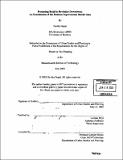| dc.contributor.advisor | Lorlene Hoyt. | en_US |
| dc.contributor.author | Gopal, Devika, 1977- | en_US |
| dc.contributor.other | Massachusetts Institute of Technology. Dept. of Urban Studies and Planning. | en_US |
| dc.date.accessioned | 2011-11-01T19:46:12Z | |
| dc.date.available | 2011-11-01T19:46:12Z | |
| dc.date.copyright | 2003 | en_US |
| dc.date.issued | 2003 | en_US |
| dc.identifier.uri | http://hdl.handle.net/1721.1/66799 | |
| dc.description | Thesis (M.C.P.)--Massachusetts Institute of Technology, Dept. of Urban Studies and Planning, 2003. | en_US |
| dc.description | Includes bibliographical references (leaves 114-123). | en_US |
| dc.description.abstract | This thesis presents pioneering research on the strategies adopted by business improvement districts (BIDs) in the United States, the United Kingdom, and Canada. The popular belief among practitioners is that where the BID approach has been adopted, downtowns have become vibrant retail destinations. However, there is no evidence to support or dispute this claim. This study supports using retail as a strategy to revitalize downtowns. It draws on literature, personal interviews, and case studies to create a Tier-structure model for describing the role and importance of BID activities. According to this model, BIDs that progress through all three Tiers are successful in holistically revitalizing downtowns. The model demonstrates how most BIDs undertake all Tier I and some Tier II activities, which are essential for creating and promoting downtown retail. However, very few BIDs engage in the vital Tier II activity of proactive retail development or undertake Tier III activities. Therefore, though BIDs are successful in changing both the physical environment and the negative perception of the downtown, their strategies do not always promote the retail mix required to ensure sustainability. Drawing on these findings, the study suggests that BIDs should engage in proactive business development strategies and adopt a more rigorous evaluation system. Following these recommendations would improve the effectiveness of their activities and result in downtowns that are vibrant retail destinations. | en_US |
| dc.description.statementofresponsibility | by Devika Gopal. | en_US |
| dc.format.extent | 153 leaves | en_US |
| dc.language.iso | eng | en_US |
| dc.publisher | Massachusetts Institute of Technology | en_US |
| dc.rights | M.I.T. theses are protected by
copyright. They may be viewed from this source for any purpose, but
reproduction or distribution in any format is prohibited without written
permission. See provided URL for inquiries about permission. | en_US |
| dc.rights.uri | http://dspace.mit.edu/handle/1721.1/7582 | en_US |
| dc.subject | Urban Studies and Planning. | en_US |
| dc.title | Promoting retail to revitalize downtowns : an examination of the business improvement district idea | en_US |
| dc.type | Thesis | en_US |
| dc.description.degree | M.C.P. | en_US |
| dc.contributor.department | Massachusetts Institute of Technology. Department of Urban Studies and Planning | |
| dc.identifier.oclc | 52971295 | en_US |
